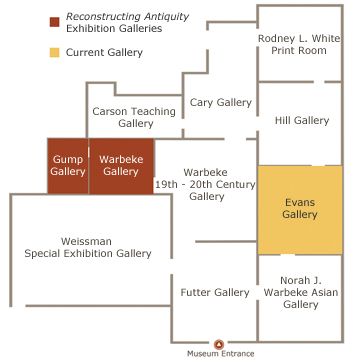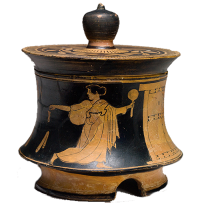Three figures in domestic scene: woman seated before a kalathos (basket of wool); man offering wool and leg of meat; woman holding mirror
Learn more about the object below
This red-figure pyxis, a round lidded box used to hold cosmetics or jewelry, dates from around 470-460 B.C. In the interior of a home, identified by the large, studded entranceway, are three figures: a woman dressed in a chiton and mantle sits holding wool while another woman stands, holding a spindle and distaff. Between them, a man, perhaps a traveler, puts a ball of wool in the kalathos, or basket. Perhaps a suitor, he offers a leg of meat, delineating his role as a hunter and provider from the women’s place in the domestic sphere.
Weaving, a common household task for Greek women, features on many ancient vessels, such as this jewelry box. Wool was washed, beaten, dyed, and rolled into balls, as seen here in the hands of the seated woman and standing man. Next, women would spin the wool, as seen here, with the woman who holds a distaff in her right hand. The wool wraps around the distaff, and the woman twists the thread in her left hand, where a spindle hangs down to carry a strand as she spins it. Weaving, though tedious and mundane, was sometimes described as a rhythmic and imaginative art form.
Label text by Sylvia Peterson (MHC, '12)
Suggested readings:
Pippa Shirley. "Pyxis." The Oxford Companion to Western Art. Ed. Hugh Brigstocke. Oxford Art Online. <http://www.oxfordartonline.com/subscriber/article/opr/t118/e2166>.
Gisela M. A. Richter, “Three Vases in the Metropolitan Museum, Illustrating Women's Life in Athens.” American Journal of Archaeology , Vol. 11, No. 4 (Oct. - Dec., 1907), pp. 417-428


